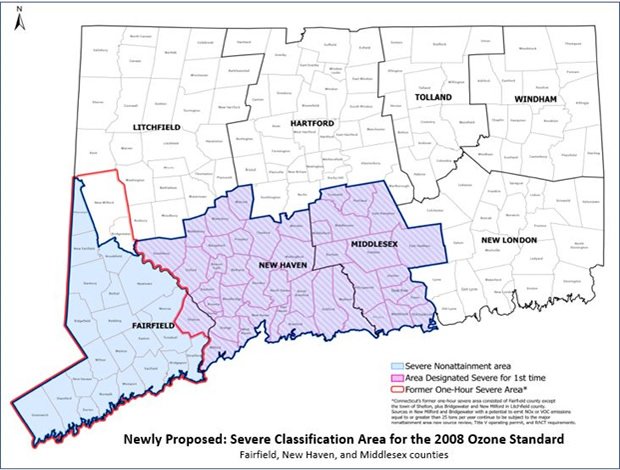EPA Proposes Attainment Status Updates for Areas in Connecticut Required to Meet Health Protection Standards for Smog
BOSTON (April 12, 2022) – Following the Clean Air Act requirements, the U.S. Environmental Protection Agency (EPA) is proposing determinations for whether certain areas of Connecticut have met the 2008 and 2015 National Ambient Air Quality Standards (NAAQS) for ground-level ozone, commonly referred to as smog. For the areas in Connecticut not meeting the ozone standards, today's proposals outline new timeframes and next steps for the state to take to improve air quality. These proposals are based on a scientific evaluation of certified, publicly-available air quality monitoring data for the years 2018 – 2020 and are taken in accordance with the Clean Air Act (CAA).
"Smog pollution is a serious threat to public health, increasing the likelihood of respiratory infections, asthma attacks, and hospital visits," said EPA Administrator Michael S. Regan. "With these proposed determinations, we are fulfilling our duty under the Clean Air Act to monitor air quality and work with states to help reduce pollution and protect the public we serve."
"EPA's proposed rulemaking will help ensure that Connecticut's air quality improves, including in areas that might be disproportionately impacted by environmental pollution," said EPA New England Regional Administrator David W. Cash. "The state of Connecticut has made great strides to implement control strategies to help improve air quality. EPA is committed to continue its strong partnership with the Connecticut Department of Energy and Environmental Protection, while also working to implement actions to address pollution from upwind states and set stronger emissions standards for mobile sources, both of which contribute to unhealthy air quality levels in Connecticut."
Ground-level ozone is not directly emitted to the air; it forms when pollutants emitted by mobile sources such as cars and trucks, power plants, a wide range of industries, and other sources chemically react in the presence sunlight. Ozone is most likely to reach unhealthy levels on hot sunny days in urban areas but it can still reach high levels during colder months. Ozone can also drift long distances and harm air quality in areas downwind of where air pollutants are emitted.
More than 79 million Americans, including those disproportionately burdened by ozone air pollution and other sources of pollution, live in areas that do not meet national air quality health standards for ground-level ozone, or smog. Today's proposal is the one of the latest in a series of actions EPA is taking to improve air quality and public health under the Clean Air Act. EPA recently proposed stronger standards to reduce pollution from heavy-duty vehicles and engines, and also proposed a federal plan to cut pollution from power plants and industrial sources that significantly contribute to unhealthy levels of smog for millions of Americans who live downwind.
EPA is required to undertake this rulemaking under the Clean Air Act to ensure that smog-affected areas can expeditiously meet health-based air quality standards for ozone. For areas being reclassified – for example, from "Marginal" to "Moderate" or from "Serious" to "Severe" – the Clean Air Act requires that states implement additional measures to protect public health and to submit new plans to demonstrate how the area will attain these standards as quickly as possible. Additionally, many areas across the country have had success with localized tools and approaches to improve ozone air quality. EPA will continue to work collaboratively with its state partners to ensure these measures are implemented to protect clean air for all communities.
Since the implementation of the Clean Air Act, the combined emissions of criteria and precursor pollutants have dropped by 78%, while our economy has grown more than 270%.
Purpose and Key Steps:
EPA is proposing its determinations for certain areas designated nonattainment for the 2008 and 2015 National Ambient Air Quality Standards (NAAQS) as required under the federal Clean Air Act (CAA). For the purposes of ozone air quality, EPA divides Connecticut into two areas: "Southwest Connecticut" covers all of Fairfield, New Haven and Middlesex counties, and "Greater Connecticut" covers all of Hartford, Litchfield, New London, Tolland and Windham counties.
For the 2008 ozone NAAQS, both the Southwest and Greater Connecticut areas are currently classified as Serious areas and were required to attain the 2008 standard by July 20, 2021. As required by section 181(b)(2) of the Clean Air Act, EPA is proposing next steps for both of these areas. EPA is proposing to determine that the Greater Connecticut area met the standard by the CAA attainment date and the Southwest Connecticut area failed to meet the standard by the attainment date and will be reclassified from "Serious" to "Severe" nonattainment.
For the 2015 NAAQS, Southwest Connecticut is currently classified as Moderate nonattainment and Greater Connecticut is classified as Marginal nonattainment. EPA is proposing to determine that the Greater Connecticut area failed to meet the standard by the attainment date and will be reclassified to a higher classification of "Moderate" nonattainment with new attainment dates.
EPA will accept comment on these two proposed actions for 60 days after publication in the Federal Register. EPA plans to hold a virtual public hearing for both proposals 25 days after publication in the Federal Register.
For more information on the proposals, the steps required by the Clean Air Act, and the areas affected, visit:
2008 Ozone National Ambient Air Quality Standards (NAAQS) Nonattainment Actions
Ground Level Ozone Pollution Proposed Determinations Attainment Date Extensions

